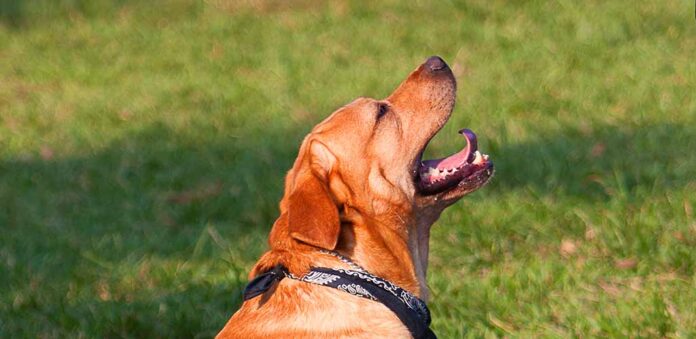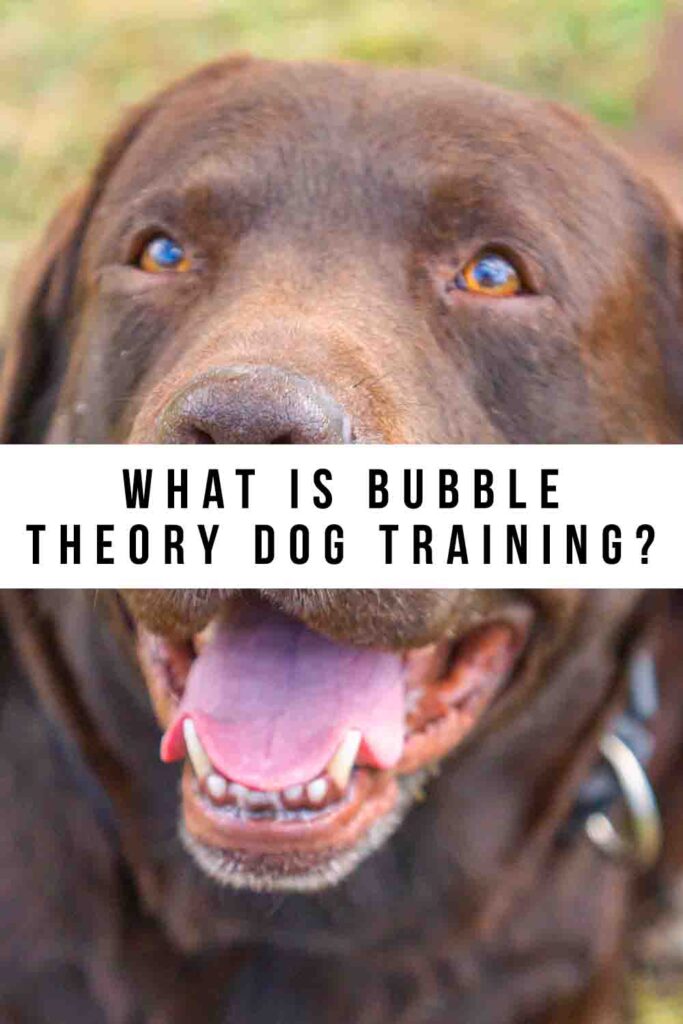[ad_1]

Have you heard about bubble theory dog training? If you have a reactive dog, I think it’s a really helpful way to visualize the problem. It doesn’t exactly add anything new to what we already know about reactivity, thresholds, and counter conditioning, but it can help you understand all of those things better – especially if you are a visual learner. And most importantly, it can improve your chances of succeeding with counter conditioning.
Contents
What is bubble theory dog training?
Bubble theory dog training is a new term to describe a well-established idea. Namely, using counter conditioning and an understanding of emotional thresholds to reduce reactive behavior. Reactive behavior is quite a broad term, to describe dogs who have a fearful or anxious reaction to specific triggers. People quite often assume it only means barking, lunging, and snapping. But in most, if not all, cases there will have been an escalating series of more subtle signals first.
Common triggers for reactivity include
- Encounters with other dogs when the reactive dog is on the leash
- Traffic
- Certain types of people (such as children, or workers in high-vis jackets and helmets)
- Sounds (like thunder, or fireworks).
Counter conditioning is the process of changing their emotional response from an extremely fearful one, to a positive one. Or at least a tolerant one.

How bubbles fit in
Let’s take as an example a dog who is reactive towards other dogs when they are on the leash. When they spot another dog 100 yards away, the reactive dog stops, freezes, and goes into ‘high alert’. If the other dog starts to approach, they bark and pull forward on the leash. If the other dog keeps getting closer, they bark more fiercely, and pull so far forward on the leash that their front paws come off the ground. At this point they’re deaf to anything you say to them, difficult to control, their behavior can injure the person on the other end of the leash, and the situation feels pretty depressing and embarrassing too.
Now let’s apply bubble theory to understand that situation better. The reactive dog feels scared, stressed, or anxious by the presence of another dog, while they are on the leash. They might be under-socialized, or they might have previously been attacked by another dog whilst leashed and unable to escape, or several minor incidents might have combined to put a significant dent in their social confidence.
The amount of space they need around them in order to feel safe is their bubble. Other dogs far beyond the perimeter of their bubble don’t concern them. Dogs right at the edge of it put them on alert. And dogs who come inside their bubble trigger a powerful reactive response, to try and drive them back out again. So at its most basic level, your dog’s bubble is the amount of personal space they need around them, in order to not feel threatened by things they’re scared of.
Bubbles and thresholds
If you have a reactive dog, it’s likely you’ve already heard the term ‘emotional threshold’. Their emotional threshold is the point at which their emotional response to something becomes so powerful that their behavior is uncontrollable. If you’ve ever walked a leash reactive dog, you’ll know that when another dog approaches, there is a tipping point after which no amount of trying to bring their focus back to you, or physically guide them away, makes any difference. They have gone ‘over threshold’.
Bubbles and thresholds are closely linked, except that ‘threshold’ describes the dog’s inner mental state, and ‘bubble’ describes how that relates to the physical space around them. In other words, reactive dogs go over their emotional threshold when their trigger comes inside their bubble. Bubble theory training is all about gradually manipulating the size of that bubble so that reactive dogs can tolerate getting closer to the things that trigger them before going over threshold.
Why bubbles?
So, bubble theory is a helpful way of appreciating how reactive dogs’ emotional state relates to the what’s going on around them. But why bubbles? Why not fences, or force fields, or auras? I think there’s a reason why using the bubble analogy is so helpful: bubbles are fragile – they pop.
Having a reactive dog is frustrating. Anyone who has struggled with it can empathize with how hard it is, and how much of the enjoyment it takes out of having a dog. So it’s understandable to be anxious for a solution, and to want the problem to be over as soon as possible. But whilst most people don’t have much trouble understanding how counter-conditioning works, lots of dog owners do struggle to respect how slowly it needs to be applied. They have a desperate urge to rush towards the end, and return to a time when their life wasn’t dominated by managing reactivity.
Picturing the limits of a dog’s confidence as a bubble, which bursts easily if you push hard at its limits, is a good way to appreciate the importance of applying counter conditioning techniques gradually.
Applying bubble theory dog training
Let’s take a more practical look at how bubble theory training could help you. Starting with whether you need it in the first place.
Dogs who can benefit
Dogs who can benefit from bubble theory training are reactive dogs with specific, identified fears. We’ve already looked at examples of things which can cause a stressed, anxious, or fearful emotional response in dogs. And we’ve touched on the fact that lots of people overlook the early clues that their dog is upset. These are all signals (in roughly ascending order) that your dog is worried by something:
- Nose licking
- Rapid blinking
- Yawning
- Turning their head away
- ‘Whale eye’ glances, where they try to keep an eye on the trigger sideways-on, and you can see the whites of their eyes
- Turning their body away
- Sitting in a fidgety, agitated way
- Pawing the ground
- Trying to move out of the way
- Ears turned backwards
- Crouching in a standing position
- Tucking their tail under
- Lying on their side with one back leg raised
- Freezing in a rigid pose
- Staring
- Barking
- Growling
- Snapping
- Biting
Not all reactive dogs will show all of these behaviors. And the more often we fail to notice the early signs, the more likely it is they will skip to the later signs next time. If your dogs is showing signs of a fearful reaction to something, bubble theory might help you with counter conditioning.
How counter conditioning with bubbles works
Counter conditioning is the process of changing a dog’s emotional response to something from a negative one, to a positive one. We do this by associating the trigger with something positive – usually an exceptionally high value food treat, like chicken. Eventually, their apprehension towards the trigger turns into anticipation of the tasty treat that comes with it, so they begin to welcome seeing (or hearing) it. For dogs who aren’t excited by food, access to a special toy or game can work instead.
Now here’s the important bit: it is only possible to change a dog’s emotional response from one side of their emotional threshold – the calm, unconcerned side. Once they go over their threshold, nothing you do will change how they feel until their trigger is gone completely. This is where imagining your dog’s bubble comes in. When you practice counter conditioning, you have to make sure their trigger is always well beyond the edges of their bubble. Over time, as their emotional response changes, the bubble will gradually get smaller. In other words the trigger can be closer, without them showing signs of fear. But if you let the trigger burst through the bubble, there’s nothing more you can do in that training session, and it might even make the reactivity worse next time. Your job is to protect the bubble!
Bubble magic
In summary, the concept of a physical bubble around our dog helps us to recognize the limits of their dog’s ability to cope with something, and keep them under threshold. From that position, we can give them high value treats, to change how they feel about things they can see or hear beyond the bubble. As their feelings change, the size of bubble they need will get smaller. Eventually, once their bubble has shrunk to a manageable size, you can go one step further, and swap the high value food treats for medium value ones, and eventually kibble.
Bubble theory dog training – summary
Bubble theory is a helpful way of thinking about counter conditioning, which relates the dog’s inner emotional state to the physical proximity of their trigger. By recognizing the significance that their personal safety bubble holds for our dogs, we are less likely to push too hard, too fast with counter conditioning.
With all complex behaviour problems, like reactivity and fear-based aggression, it always a good idea to have your vet rule out medical factors like pain before you embark on a training solution. If you struggling, an experienced force-free behaviourist who can visit you and observe your dog in person can help. Your vet can signpost you to suitable behaviorists working in your area.
If you try using this training technique with your dog, we’d love to hear from you in the comments box down below! Were your experiences positive, or negative? Would you recommend it to other people?

The Labrador Site Founder

Pippa Mattinson is the best selling author of The Happy Puppy Handbook, the Labrador Handbook, Choosing The Perfect Puppy, and Total Recall.
She is also the founder of the Gundog Trust and the Dogsnet Online Training Program
Pippa’s online training courses were launched in 2019 and you can find the latest course dates on the Dogsnet website
[ad_2]
Source by [author_name]



